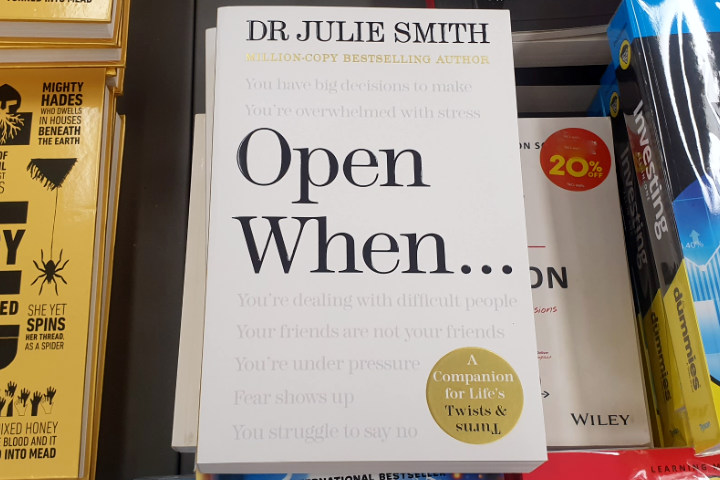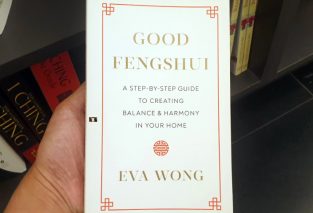Explore a heartfelt journey through letters offering guidance, comfort, and wisdom. Where life’s challenges are navigated with love, encouragement, and personal reflections, providing hope and connection in difficult times.

“Open When” by Dr Julie Smith is a literary gem that invites readers into a world where words are keys, unlocking emotions and memories that might otherwise remain hidden.
It’s a book that delves into the intricacies of human relationships. And the author does that with grace and poignancy.
We are taken on an emotional journey through a deeply introspective lens, where the art of letter-writing becomes an unexpected, yet powerful form of connection.
The narrative unfolds like a series of letters, each one a time capsule filled with sentiment and revelation, weaving together a tapestry of love, loss, and redemption.
From the very first letter, the book drips with nostalgia, intimacy, and the rawness of human emotions, drawing us into a story that feels as much about the recipient as it does the writer.
The concept of “open when” letters is deceptively simple yet profoundly impactful.
It serves as the backbone of the book, where characters communicate across time and distance, bridging gaps with handwritten missives meant to be opened at just the right moment.
This narrative device not only propels the story forward but also creates an intimate connection between the characters and reader, as if we too are receiving these letters, privy to their innermost thoughts and feelings.
The character that is writing these carefully crafted letters is laden such authenticity that it’s as if she leaps off the page. Igniting smouldering joys and sorrows resonating long after the book is closed.
The protagonist, is you. On a journey of self-discovery, as you navigate the complexities of love and friendship with a vulnerability that is both relatable and inspiring. Through your eyes, you learn that life’s challenges often come wrapped in opportunities for growth, much like a letter marked “open when you need hope.”
Each letter addresses the emotional state or situation you find yourself in. Whether you are feeling lonely, heartbroken, or in need of guidance. These letters, written by a dear friend or even someone more significant, open doors to parts of your heart you might have otherwise neglected.
These letters are like portals that dig into the deeper recesses of the human soul. Places often untouched by our fast-paced world. The author knows we need to confide in her, and in doing so with her letter, perhaps, you can’t help but feel that we begin to unravel a little bit of ourselves.
Each letter isn’t just a note on a piece of paper. It’s a form of life instruction, an anchor, and at times, a lifeline.
The beauty in this, however, isn’t just the act of receiving these letters but the way each one challenges the you to confront parts of yourself you have buried deep within.
For instance, one letter reminds us to embrace vulnerability and open ourself to the possibility of love again after a devastating heartbreak. Another letter urges us to stop searching for approval and to find validation within ourselves. Through these letters, we experiences both joy and heartache, growth and stagnation much like we would through such moments of reflection.
The emotional depth of “Open When” is beautifully balanced with moments of levity and wit. The manner in which humor is used is both clever and heartwarming, reminding us that even in the darkest times, there is room for laughter.
At one point, I couldn’t help but feel that love life mimics a poorly written novel—full of plot holes and questionable character development. It’s this kind of light-hearted banter that endears the characters to us, making their struggles all the more poignant.
The storytelling flair shines not only in the premise of the book but in the intricate details that lace each letter with significance.
There is an unmistakable underlying theme of forgiveness.
Smith deftly explores how forgiveness is not just an act but a process. A journey towards healing that requires time and patience. Where characters grapple with past mistakes and misunderstandings, ultimately finding peace in letting go. This theme is encapsulated in a segment on self-forgiveness. Serving as a gentle reminder that holding onto resentment only weighs us down.
In some moments, I was particularly struck by the power of words to shape our reality.
The letters serve as anchors for readers, grounding us in moments of uncertainty and providing clarity when needed most. A testament to Smith’s skill as a writer that she can convey such profound truths through seemingly simple correspondence.
I’m genuinely in awe.
There’s a remarkable delicacy in her language.
It’s never overbearing but leaves room for interpretation.
Every letter that I “open” is brimming with layers of meaning, and as I processes them, I’m unknowingly drawn into the reflective process.
Thoughts transform from confusion to clarity, from doubt to belief, and from solitude to connection.
It’s as if my own emotional evolution was being laid out.
If you ever find yourself in circumstances of grief, loss, and the baggage of the past, this book might just be the antidote to help you start shedding your past selves like layers of a forgotten skin.
There’s a poignant realization that the letters were never just meant for us, but were part of a process of Smith’s own self-discovery.
But don’t expect to suddenly leap to happiness or have an epiphany that solves all your problems after reading this book.
Instead, welcome a gradual transformation, as if you are learning to see the world and yourself in a new light. It’s a reminder that true growth isn’t instantaneous, and healing is a journey that takes time.
Like the perfect recipe for emotional healing, the book mixes moments of melancholy with subtle doses of humor, providing an emotional balance that is satisfying and relatable.
In many ways, the book reads like a quiet conversation between the reader and the author. It’s not loud or brash, but it stays with you. Much like the letters in the novel, the narrative feels like a whisper rather than a shout.
Biggest Takeaway
The biggest idea that stared right back at me as I closed the book is the importance of connection. Both with others and ourselves.
In a world where communication is often reduced to fleeting texts and emojis, it reminds us of the enduring impact of heartfelt words.
Sometimes, the best form of communication is one that takes its time, one that feels deliberate, weighted, and personal.
It used to be this way all the time before the storm of mobile phones and social media took over the world.
The small acts of kindness we may offer, even in the form of a letter, can have a lasting impact.
This novel, if I can call it as such, encourages us to slow down and savor the written word. To cherish the connections we forge through thoughtful communication.
In a way, the journey through this book is a reflection of how we all move through the world. We’re constantly seeking meaning, longing for connection, and grappling with our internal struggles.
Sometimes, we need someone else to remind us of who we are or who we can become. The author does this beautifully by showing that the power of love, friendship, and even self-love can be transmitted through something as simple as written words.
There’s also a certain magic in how these letters are delivered, as they are meant to address pivotal moments in life. It’s almost as though these letters hold the answers to questions we haven’t yet asked, providing clarity just when we’re about to give up hope.
It’s a powerful metaphor for life itself. Answers often arrive when we least expect them, sometimes from sources we never anticipated.
In the words of a letter, in the warmth of a friend’s voice, or in the quiet moments of introspection.
There is also an underlying message that healing is an ongoing process, and it often comes from unexpected places.
We tend to think of healing as a single event or a finished product, but the book reminds us that it’s more like a conversation. One that we continually have with ourselves, with others, and sometimes, with the past.
It’s about accepting that we will always be a work in progress, and that’s okay. Just as reading this book progresses one letter at a time, so too does our growth as individuals.
This is a masterful exploration of human relationships, told through the lens of letters that reveal as much about the sender as they do the recipient.
The flowing narrative weaves together humor, heartache, and hope, creating a story that lingers in the mind like a melody long after it’s been played.
For those seeking a tale that speaks to the soul, “Open When” is a must-read. Because sometimes, all it takes is the right words at the right time to change everything.
And remember, when life gives you letters, open them with care. You never know what treasures you’ll find inside.




